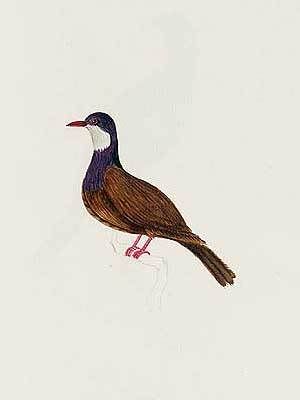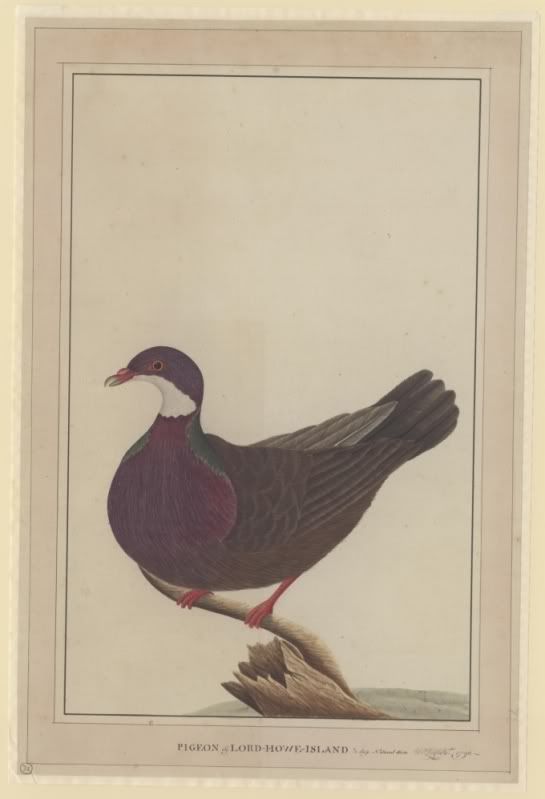|
|
Post by Melanie on May 16, 2005 17:59:00 GMT
Columba vitiensis godmanae
last observed in 1788 by T. Gilbert on Lord Howe Island
arboreal island forest herbivore endemic to Lord Howe Island
no known specimens
disappeared after deforestation
|
|
|
|
Post by Melanie on May 16, 2005 18:02:10 GMT
 painted by George Raper www.nhm.ac.uk/library/art/drawingconclusions/more/pigeon_more_info.htm#When Lord Howe Island was discovered in 1788, the pigeons were abundant. Generally brown, with a purple-mauve head and breast, and a white throat and upper neck, they were larger than a domestic pigeon. As the island had been previously uninhabited, the pigeons were very tame and naturally curious and so were easily caught in large numbers by sailors and settlers. Sadly, the White-throated Pigeon quickly became consigned to history and extinction. The last birds were seen in 1853, leaving only two paintings and a few sparse accounts to record the existence of this unique Lord Howe Island bird. |
|
|
|
Post by another specialist on Jun 11, 2005 12:04:38 GMT
Known by 2 paintings and accounts of 18th century travellers. The first painting by midshipman george raper of hms sirius about the year 1790 is now in british museum - natural history. The second painting, by an unknown, is in the alexander turnball library in wellingtom, new zealand, and is nowadays considered to be a copy by hindwood in 1940, this author quotes thomas gilbert who visited the island in 1788.
On entering the woods i was surprised to see large fat pigeons... sitting on low bushes and so insensible to fear, as to be knocked down with little trouble.
By the year 1853 the population had apparently been extirpated, for the naturalist mac guillivary was not able to find one.
from
Extinct and vanishing birds of the world
by James C. Greenway Jr.
|
|
|
|
Post by sebbe67 on Jun 12, 2005 19:51:30 GMT
This subspecies of the White-throated Pigeon was
endemic to Lord Howe Island. Some of the first
visitors to the island described it as abundant
(Hindwood, 1940). Others, even as early as 1791, had
difficulty obtaining live specimens (McKean and
Hindwood, 1965). Hindwood (1940) suggests thousands
were killed for food, but this would have to have
been over many years as it is unlikely the island could
have sustained such a large population (J. Disney). The
subspecies was certainly very rare by 1853 and there
are no subsequent records (Hindwood, 1940). No
specimens are extant, and the subspecies’ identity is
known only from paintings.
The last reports of this species were in the 1850s.
The White-throated Pigeon evidently occurred
throughout the lowlands of Lord Howe I. and was
probably in all wooded habitats. It is likely that the
pigeons fed on fruits and seeds (Hutton, 1991).
Large numbers of White-throated Pigeons were killed
for food, and this was probably the reason for the
bird’s extinction (Hindwood, 1940).
|
|
|
|
Post by another specialist on Jun 13, 2005 5:41:56 GMT
what source was your info found sebbe67?
Just nice to know where information & pics etc come from for reference purposes....
Plus members/ readers may want to go to the original source for further reading or possible changes/ additions that may be done in the future to the source.
Something you can refer back to....
|
|
|
|
Post by sebbe67 on Jun 13, 2005 6:28:16 GMT
|
|
|
|
Post by another specialist on Jun 13, 2005 8:23:19 GMT
thanks sebbe67
|
|
|
|
Post by another specialist on Jun 13, 2005 8:24:11 GMT
|
|
|
|
Post by another specialist on Oct 31, 2005 10:21:17 GMT
|
|
|
|
Post by Melanie on Nov 4, 2005 23:59:06 GMT
This drawing by George Raper, dated 1790, was titled Pigeon of Lord Howe Island. The island is situated in the southwest Pacific Ocean, three hundred miles east of Port Macquarie on the Australian coastline. This is the only location where the pigeon has been found. Furthermore, the species is known only from this painting, and one other very similar painting held in the Alexander Turnbull Library in New Zealand. Only brief notes about this bird exist in early records and no museum specimen exists today.
George Raper indicates on his painting that the bird is shown one-third less than its natural size. Although he did not land on the island, he may have seen live birds of this sub-species which had been brought to Sydney Cove in March 1788.
The bird was first scientifically described in 1915 by Gregory M. Mathews, using the painting shown here. It was then in the possession of Frederick Du Cane Godman, who named the bird (Raperia godmae) after George Raper and Godman's wife. The bird is now thought to be a sub-species and is known today as the White-throated Pigeon (Columba vitiensis godmanae). As an important record of a vanished bird this painting continues to be referred to by ornithologists and historians, most recently in a paper by C. T. Fisher and F. E. Warr (2003).
|
|
|
|
Post by another specialist on Nov 5, 2005 21:21:56 GMT
|
|
|
|
Post by another specialist on Aug 18, 2007 23:55:10 GMT
|
|
|
|
Post by another specialist on Aug 28, 2007 9:55:41 GMT
Another version of same image above  artwork by ? from 'Album of watercolour drawings of Australian natural history' from the year ca. 1800 Photo: by courtesy of Jennifer Broomhead / State Library of New South Wales www.sl.nsw.gov.au |
|
|
|
Post by another specialist on Apr 23, 2008 18:29:49 GMT
 painted by George Raper www.nhm.ac.uk/library/art/drawingconclusions/more/pigeon_more_info.htm#When Lord Howe Island was discovered in 1788, the pigeons were abundant. Generally brown, with a purple-mauve head and breast, and a white throat and upper neck, they were larger than a domestic pigeon. As the island had been previously uninhabited, the pigeons were very tame and naturally curious and so were easily caught in large numbers by sailors and settlers. Sadly, the White-throated Pigeon quickly became consigned to history and extinction. The last birds were seen in 1853, leaving only two paintings and a few sparse accounts to record the existence of this unique Lord Howe Island bird. A clearer image of the above  www.fathom.com/feature/121889/index.html www.fathom.com/feature/121889/index.html |
|
|
|
Post by another specialist on Jul 23, 2009 10:42:57 GMT
 painted by George Raper www.nhm.ac.uk/library/art/drawingconclusions/more/pigeon_more_info.htm#When Lord Howe Island was discovered in 1788, the pigeons were abundant. Generally brown, with a purple-mauve head and breast, and a white throat and upper neck, they were larger than a domestic pigeon. As the island had been previously uninhabited, the pigeons were very tame and naturally curious and so were easily caught in large numbers by sailors and settlers. Sadly, the White-throated Pigeon quickly became consigned to history and extinction. The last birds were seen in 1853, leaving only two paintings and a few sparse accounts to record the existence of this unique Lord Howe Island bird. A clearer image of the above  www.fathom.com/feature/121889/index.html www.fathom.com/feature/121889/index.htmlAnd a image showing the full drawing  "Pigeon of Lord Howe Island" Artist: Raper, George Created: [1790] Dimensions: 48.7 x 32.2 cm Reference: Raper Drawing - no. 72 |
|
|
|
Post by surroundx on May 24, 2015 10:17:09 GMT
|
|
|
|
Post by Melanie on Jun 30, 2015 13:43:02 GMT
|
|
|
|
Post by Melanie on Jun 30, 2015 13:48:09 GMT
|
|
|
|
Post by surroundx on Aug 28, 2016 11:53:27 GMT
|
|
|
|
Post by Melanie on Apr 3, 2022 20:46:41 GMT
According to the Action Plan for Australian Birds 2020 the common name has been changed to Lord Howe Metallic Pigeon.
|
|